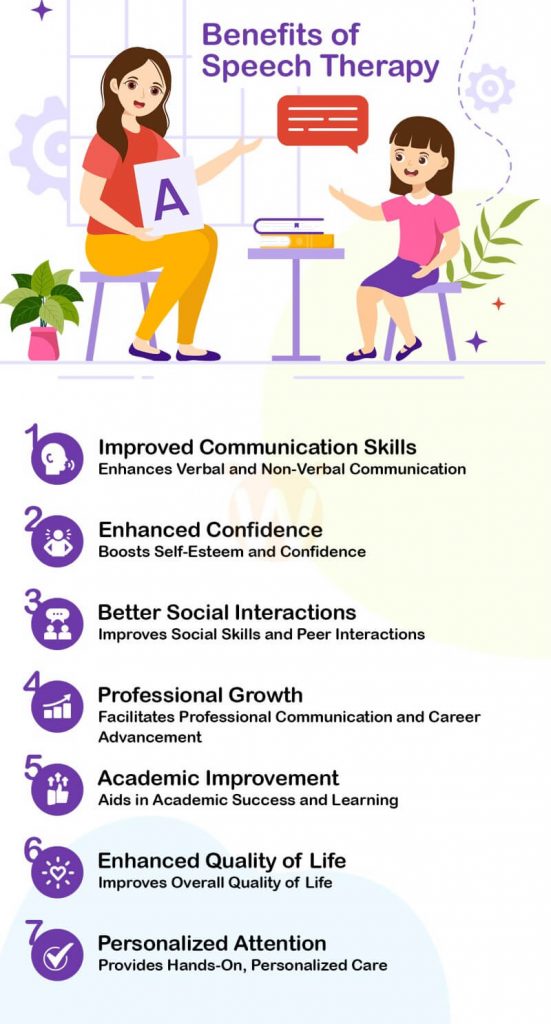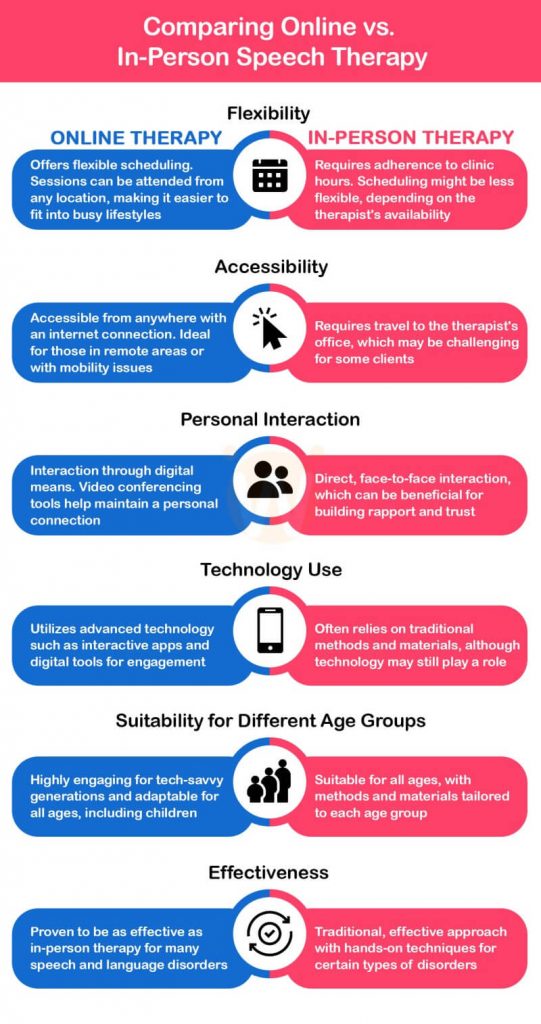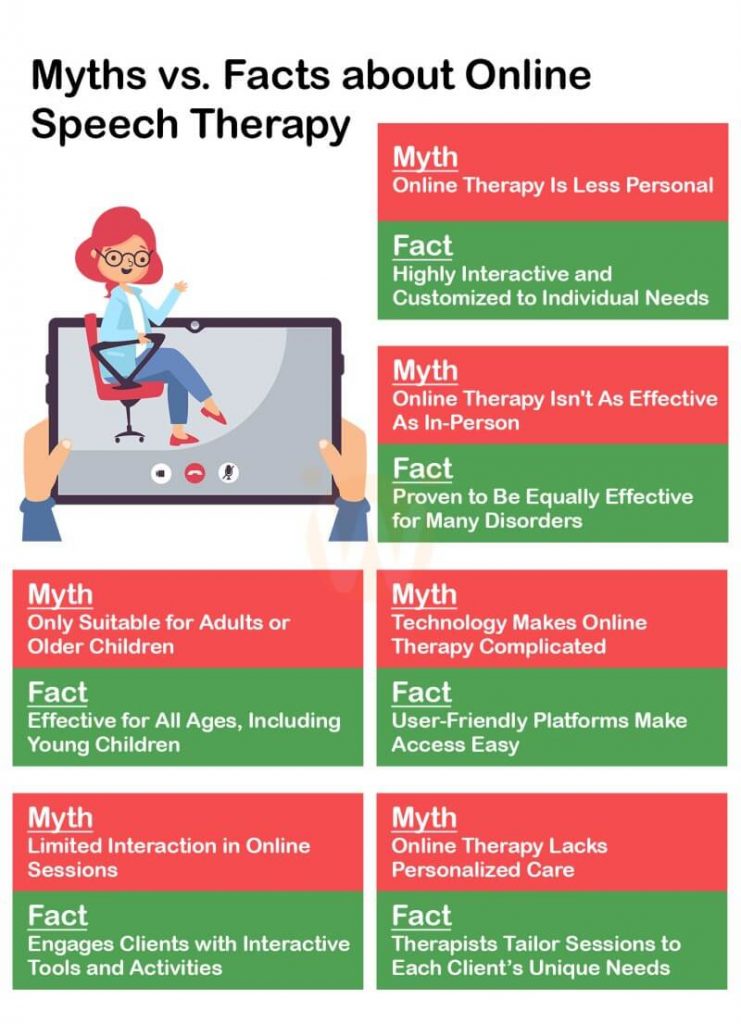In-Person vs. Online Speech Therapy: Which is More Effective?
By Rajini D
Last Updated: December 19, 2023
Speech therapy, a vital service that transforms lives, has long been a cornerstone in helping individuals overcome communication barriers. Traditionally, this therapy involved face-to-face interactions in a clinical setting. However, as our world embraces digital innovation, speech therapy has also evolved, leading to the emergence of online alternatives.
Book a free Online Speech Consultation.

The Rise of Online Speech Therapy
What is Online Speech Therapy?
At its core, online speech therapy, or teletherapy, is the provision of speech therapy services through a digital platform. This method allows clients to connect with certified speech-language pathologists via the internet, breaking down geographical barriers and bringing the therapy session right into your living room. But what exactly does this mean for those in need of speech therapy?
The Technological Leap Forward
The effectiveness of online speech therapy is largely attributable to the leaps and bounds made in technology. High-quality video conferencing tools, interactive software, and innovative digital resources have revolutionized the way speech therapy is delivered. These advancements not only mimic the traditional therapy environment but also add unique elements that can enhance the therapeutic experience.
For example, engaging digital games and exercises tailored to speech and language development can make sessions more engaging, especially for younger clients. Additionally, the ability to record sessions for later review allows for a more reflective and personalized therapy experience.
Teletherapy: A Growing Trend
The concept of teletherapy, once a niche service, has now become increasingly mainstream. This surge in popularity isn’t just due to technological advancements; it also stems from the need for flexible and accessible healthcare solutions. Online speech therapy addresses this need perfectly, offering services that are not constrained by location, travel time, or traditional office hours.
For individuals in remote or underserved areas, or for those with mobility challenges, online speech therapy opens up new possibilities for receiving care. It also offers a level of comfort and familiarity by allowing clients to engage in therapy from their own homes.
Book Online Speech Therapy Session Now.
Comparing Effectiveness – Online vs. In-Person
When considering speech therapy, a key question often arises: How does the effectiveness of online therapy compare to traditional in-person sessions? Let’s explore this with a focus on practical outcomes and real-world applications.

Online vs. In-Person: Effectiveness Compared
The core of speech therapy, whether online or in-person, lies in its ability to address communication challenges effectively. Studies have shown that online speech therapy can be just as effective as in-person sessions. For instance, research by the American Speech-Language-Hearing Association (ASHA) indicates that teletherapy yields comparable results to traditional therapy in various aspects, including speech sound production and language skills development.
The effectiveness of both modes depends significantly on individual factors such as the therapist’s skill, the client’s engagement level, and the specific speech disorder being addressed. What’s crucial is the personalized approach tailored to each client, whether they’re interacting through a screen or sitting across from the therapist.
Engagement and Interaction in Online Settings
One of the initial concerns about online speech therapy is the potential lack of engagement and interaction. However, this concern has been largely dispelled by the creative use of technology in teletherapy sessions. Therapists employ interactive games, digital worksheets, and engaging exercises that not only maintain but often enhance engagement levels, especially among younger clients.
Furthermore, the convenience and comfort of being in one’s own environment can lead to increased focus and participation, making online sessions as interactive, if not more so, than in-person ones.
Debunking Myths and Misconceptions
Despite the growing popularity and proven effectiveness of online speech therapy, certain myths and misconceptions still persist. Let’s address some of these and contrast them with factual information.
Myth 1: “Online Therapy Is Less Personal”
A common myth is that online speech therapy lacks the personal touch of in-person sessions. Contrary to this belief, teletherapy can be highly personalized. Therapists are adept at creating a connection with their clients, using technology to bridge the physical gap. Video conferencing allows for face-to-face interaction, and therapists often utilize digital tools to create custom activities suited to each client’s needs.
Myth 2: “Online Therapy Is Only for Mild Cases”
Another misconception is that online therapy is only suitable for mild speech disorders. In reality, teletherapy has been successfully used for a wide range of speech and language issues, from mild articulation difficulties to more complex conditions like aphasia. The key is a well-structured therapy plan and a skilled therapist, elements that Wellness Hub focuses on in its online speech therapy services.
Myth 3: “Technology Complicates Therapy”
While it’s true that online therapy requires a basic setup of a computer and internet connection, once these are in place, technology often enhances the therapy experience. Digital tools and software are used to create interactive and engaging sessions, which can be more appealing and effective, especially for the tech-savvy younger generation.

In debunking these myths, it’s clear that online speech therapy is not just a viable alternative to traditional therapy, but it can also offer unique advantages. It’s about choosing the right mode that aligns with your specific needs and circumstances, a choice that Wellness Hub can assist you with through their expert services.
Accessibility and Convenience of Online Speech Therapy
In the evolving landscape of speech therapy, accessibility and convenience play pivotal roles. Online speech therapy emerges as a front-runner in making therapy more accessible than ever before.
Embracing the Ease of Access
The accessibility of online speech therapy has opened doors for many who previously found it challenging to receive treatment. Geographic limitations, mobility issues, and time constraints are no longer barriers. Anyone with an internet connection can access quality speech therapy, a fact that makes this mode a game-changer in the field of speech and language pathology.
Home: The New Therapy Space
Imagine the comfort and familiarity of your home merging with the professional setting of a speech therapy session. This is the convenience online speech therapy offers. It eliminates travel time and associated stress, making therapy sessions more relaxed and effective. This is particularly beneficial for children and individuals who may feel more at ease in their home environment, allowing them to focus better on the therapy itself.
Comparing with In-Person Sessions
While in-person therapy has its merits, including hands-on techniques and direct interaction, it often involves logistical considerations like commuting, scheduling around office hours, and sometimes waiting in reception areas. Online therapy, in contrast, simplifies these logistics significantly, providing flexibility that can be particularly advantageous for busy families or professionals.
Technology Tools in Online Therapy
| Technology Tool | Purpose/Benefit in Online Therapy |
|---|---|
| Video Conferencing Platforms | Enables real-time face-to-face interaction with therapists; essential for assessing verbal and non-verbal cues. |
| Interactive Games | Engages clients, especially children, in therapy through fun, interactive activities that target specific speech and language skills. |
| Digital Worksheets and Activities | Provides a variety of exercises and tasks that clients can work on during and outside of therapy sessions. |
| Speech Articulation Apps | Helps in practicing and improving pronunciation and clarity of speech. |
| Virtual Whiteboards | Allows therapists to visually illustrate concepts and exercises, and clients can interact in real-time. |
| Online Assessment Tools | Facilitates the evaluation of a client’s progress and specific areas of need in speech and language development. |
| Voice Analysis Software | Used for monitoring and improving voice quality, pitch, and volume. |
| Language Development Apps | Offers a range of activities focused on building vocabulary, grammar, and overall language skills. |
| Teleprompters and Reading Apps | Assists in fluency practice and reading comprehension exercises. |
| Augmentative and Alternative Communication (AAC) Tools | Provides solutions for individuals with severe speech and language impairments to communicate effectively. |
Tailoring Therapy to Individual Needs
Whether it’s online or in-person, the customization of therapy to meet individual needs is paramount in speech therapy.
Adapting to All Ages and Needs
Online speech therapy is not a one-size-fits-all solution; it’s adaptable to different age groups and needs. For children, engaging digital tools and interactive games can make learning fun and effective. Adults may appreciate the focused and convenient nature of online sessions, which can be tailored to their specific challenges, whether in a professional or social context.
In-person therapy also offers customization, with therapists using a range of techniques and materials suited to the client’s age and developmental stage. However, the innovative use of technology in online therapy can create an equally engaging and personalized experience.
Customization in Both Settings
Both online and in-person therapies allow for the development of personalized treatment plans. These plans are based on thorough assessments and tailored to the client’s unique communication goals. Whether it’s articulation exercises for a child, language development activities for individuals with developmental delays, or accent modification for non-native speakers, both modes are equipped to address these diverse needs effectively.
Understanding Speech Delay: Causes, Milestones, and Therapy.
Therapy Goals and Methods
| Therapy Goals | Online Therapy Methods | In-Person Therapy Methods |
|---|---|---|
| Articulation | – Use of interactive apps for pronunciation practice – Video modeling and feedback | – Hands-on articulation exercises – Physical modeling of mouth movements |
| Fluency | – Online fluency-enhancing games – Digital tools for pacing and rhythm exercises | – Direct speech exercises – Breathing and relaxation techniques in a controlled setting |
| Language Development | – Virtual storytelling sessions – Online language games and activities | – Real-life conversational practice – Use of tangible educational materials |
| Social Communication Skills | – Role-playing through video conferencing – Social scenario simulations online | – Group therapy sessions – Face-to-face interaction and social skill activities |
| Voice Disorders | – Digital voice recording and analysis tools – Online voice modulation exercises | – In-clinic voice therapy equipment – Direct vocal exercises and therapist feedback |
| Cognitive-Communication Skills | – Memory and problem-solving activities online – Virtual cognitive exercises | – In-person cognitive-linguistic tasks – Hands-on activities for memory retention |
Choosing the Right Mode for You or Your Child
Making the right choice between online and in-person speech therapy can be pivotal in the journey towards effective communication. When considering the options, it’s important to weigh several factors to ensure the chosen mode aligns well with your or your child’s needs.
Personal Preference and Comfort
Start with personal comfort and preference. Some individuals might prefer the face-to-face interaction that in-person sessions offer, finding it more engaging and easier to connect with the therapist. Others might find the online environment less intimidating, particularly beneficial for those who are more reserved or anxious in new settings.
Specific Needs and Therapy Goals
Consider the specific speech and language goals. Online speech therapy can be highly effective for a range of needs, from articulation issues to language delays. However, certain conditions might benefit more from the hands-on techniques and immediate feedback that in-person therapy can provide.
Environmental Considerations
Think about your environment. Do you have a quiet, private space for online sessions? Is your internet connection reliable? For in-person therapy, consider the travel time and the feasibility of regular visits to the therapist’s office.
Remember, the effectiveness of speech therapy, whether online or in-person, largely depends on consistent participation and the quality of interaction with the therapist.
The Role of Wellness Hub in Speech Therapy
When navigating the choices for speech therapy, Wellness Hub emerges as a supportive guide, offering both online and in-person options.
Facilitating Access to Quality Therapy
Wellness Hub understands the importance of accessibility in healthcare. By offering both online and in-person speech therapy, we ensure that our clients have the flexibility to choose a mode that best suits their individual needs and circumstances.
Tailored Services for Diverse Needs
At Wellness Hub, we pride ourselves on the quality and adaptability of our services. Our team of experienced speech therapists is skilled in delivering personalized therapy plans, whether it’s through a screen or in a traditional clinic setting. We focus on creating an engaging, supportive, and effective therapy environment, tailored to each client’s unique journey.
Commitment to Excellence
Our commitment at Wellness Hub is to provide exceptional care and support throughout your speech therapy journey. Whether you opt for the innovative approach of online therapy or prefer the conventional in-person sessions, our goal is to ensure that you receive the best possible care tailored to your specific needs.
Conclusion
In this exploration of speech therapy, we’ve delved into the nuances of both in-person and online methods. We’ve seen that while each mode has its unique characteristics, both can be remarkably effective in the right circumstances. The key is to understand your or your child’s specific needs, preferences, and environment to make the best choice.
Both online and in-person speech therapies have their place in the world of communication enhancement. Online therapy offers unparalleled convenience and accessibility, breaking down geographical barriers and providing comfort in familiar settings. In contrast, in-person therapy offers tangible, hands-on interaction and immediate feedback in a structured environment.
At Wellness Hub, we are committed to offering both these options, understanding that each individual’s journey towards better communication is unique. Our goal is to provide quality care and support, whether you join us online or in person.
Remember, the path to effective communication is a personal journey. Whether it’s online or in-person, what matters most is finding the right fit that empowers you or your loved one to communicate confidently and effectively.
Frequently Asked Questions
1. Can online speech therapy be as effective as in-person therapy?
Yes, numerous studies and practical experiences have shown that online speech therapy can be as effective as in-person sessions. The effectiveness depends on factors like the therapist’s expertise, the client’s engagement, and the use of appropriate technology.
2. Is online speech therapy suitable for all ages?
Online speech therapy can be tailored to suit individuals of all ages, from young children to older adults. Therapists use various interactive tools and techniques to engage clients effectively, regardless of their age.
3. How do I know if online speech therapy is the right choice for me or my child?
Choosing between online and in-person speech therapy depends on personal preference, specific needs, and practical considerations like accessibility and comfort. Consulting with a speech therapist, like those at Wellness Hub, can help you make an informed decision.
4. What are the key benefits of online speech therapy?
Online speech therapy offers several benefits, including greater flexibility in scheduling, the comfort of receiving therapy from home, and access to a wider range of therapists. It’s particularly beneficial for those in remote areas or with mobility constraints.
5. How does in-person speech therapy enhance the therapeutic experience?
In-person speech therapy provides direct interaction with the therapist, which can be crucial for certain types of speech and language disorders. It allows for hands-on activities and immediate feedback, making it highly effective for some individuals.
6. Can speech therapy help with accent reduction?
Yes, speech therapy can be instrumental in accent reduction. Both online and in-person speech therapy provide techniques and exercises focused on pronunciation, intonation, and speech clarity, helping individuals improve their accent.
7. Is speech therapy only for children, or can adults benefit too?
Is speech therapy only for children, or can adults benefit too? A4: Speech therapy is beneficial for individuals of all ages. While it’s commonly associated with children, many adults seek speech therapy for various reasons, including accent modification, recovery from a stroke or injury, and improving professional communication skills.
8. How long does a typical speech therapy program last?
The duration of a speech therapy program varies depending on the individual’s needs, goals, and progress. Some may see improvements in a few months, while others might need longer-term support. A personalized approach ensures that each client receives the right duration of therapy for their specific situation.
9. Are there any specific technologies or apps used in online speech therapy?
Online speech therapy utilizes various technologies and apps designed to enhance the therapeutic experience. These include video conferencing tools, interactive language games, speech articulation apps, and digital worksheets. These tools are chosen to meet the specific needs of each client.
10. How do I choose the right speech therapist for my needs?
Choosing the right speech therapist involves considering their qualifications, experience, specialization, and approach to therapy. It’s also important to feel comfortable and establish a good rapport with the therapist. At Wellness Hub, we offer assistance in matching clients with therapists who best suit their individual needs.
About the Author:
Rajini,
Speech-Language Pathologist:
Rajini
is a dedicated Speech-Language Pathologist with a focus on developmental speech
and language disorders in children and rehabilitation in adults. With a passion
for helping each individual find their voice, Rajini brings a wealth of
experience and a heartfelt approach to therapy. At Wellness Hub, she’s part of
a team that values innovation, compassion, and results-driven practices.
Book your Free Consultation Today
Parent/Caregiver Info:
Client’s Details:
* Error Message









